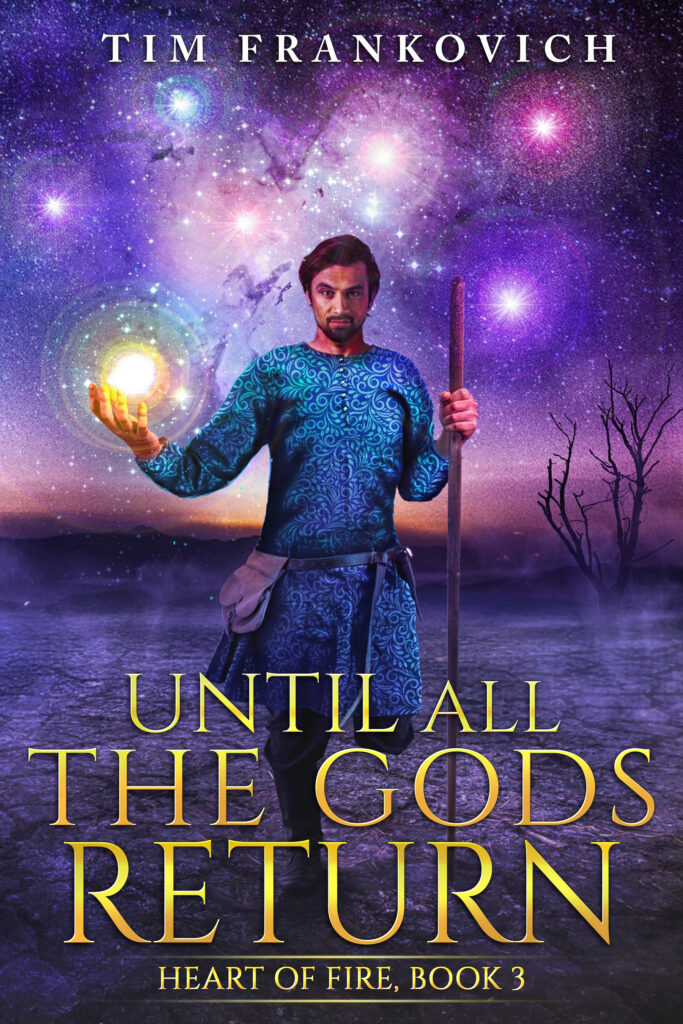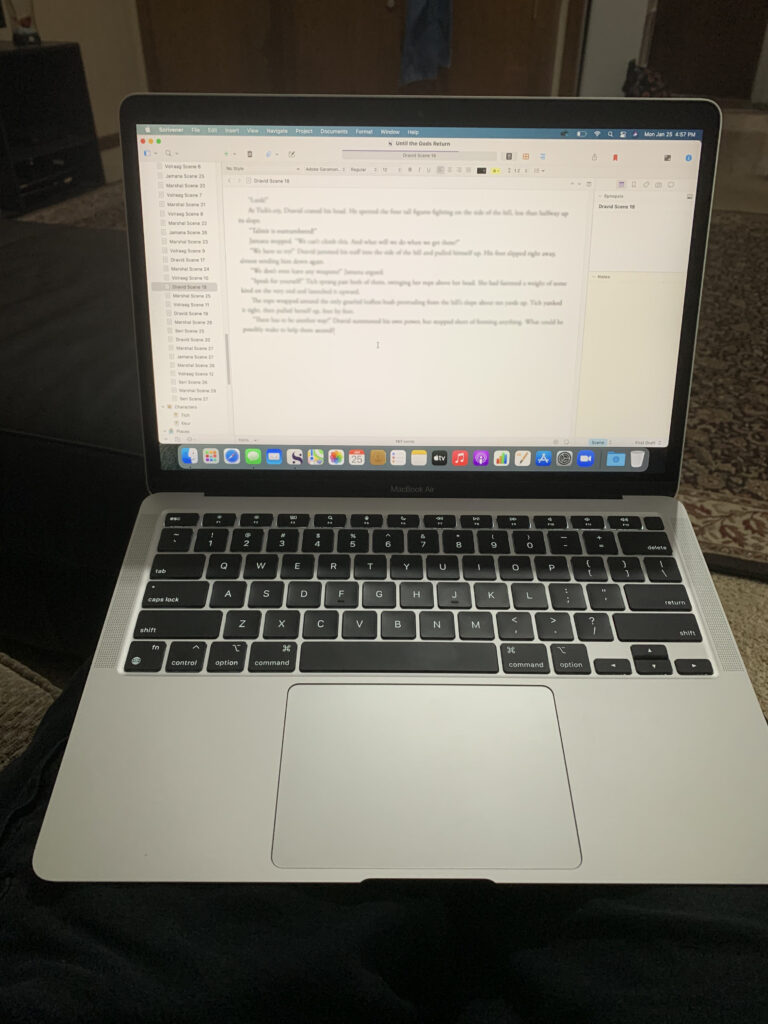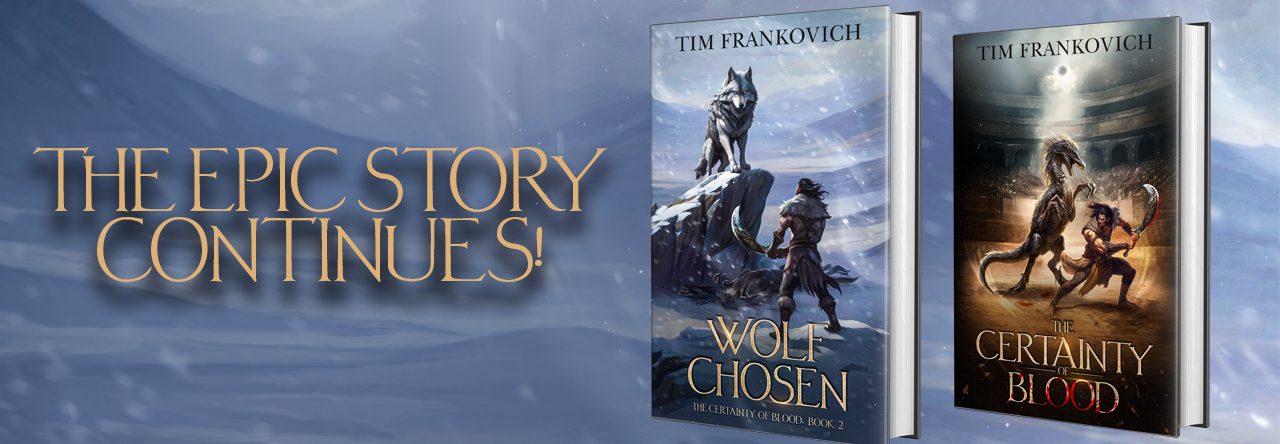I messed up. Somehow, I failed to click the one little button that made Until All The Gods Return available on Kindle Unlimited at its launch. I have corrected that now, but Amazon takes a while to process it. If you were looking for that particular option, please be patient. It’s coming!
Category: Writing Page 6 of 15

Until All The Gods Return is officially available today wherever you buy books! And to celebrate, the first book in the Heart of Fire series, Until All Curses Are Lifted, is absolutely FREE on Amazon all this week! What are you waiting for? Start reading!
Less than two weeks until the release day! And now you can read the third chapter of Until All The Gods Return, the third book in the Heart of Fire series.
At the end of Until All Bonds Are Broken, Dravid sacrificed his freedom for Seri. He became a slave to one of the ancient gods. How’s that working out for him by now? Read and find out!
Until All The Gods Return releases on May 25.

The first chapter of Until All The Gods Return, book 3 in the Heart of Fire series, is now available for your reading pleasure right here.
Jamana discovers he doesn’t want to be part of an event, but leaving may not be so easy.
Remember: subscribers to the newsletter get these kind of updates much earlier AND get free tie-in short stories to read! You should subscribe. No, really. You should.
Releasing on May 25, 2021! Here’s the cover for book three in the Heart of Fire series, Until All the Gods Return. Available for pre-order now!

I promised it last year, and it’s finally here.
I’ve written a short story tie-in with Viridia and the Dragontek Lore series. The character Richard Onyx shows up out of nowhere in chapter one of Viridia. He’s reluctant to speak about his past, though he admits to being part of a previous rebellion in the city of Atramentous.
This is the story of Rick’s final day in Atramentous. The end of one rebellion and the beginning of a new one. Before he can leave Atramentous, Rick must deal with the deadly wrath of the draconic, Naram-Sin Black…
There’s only one way to read this story, along with the Heart of Fire tie-in story, The Leper’s Second Kill. Sign up for my newsletter! Not only will you get links to both of those stories, but you’ll be able to keep up with all of my news about writing and other stuff, and you’ll get regular special offers for other books! What have you got to lose? Sign up now!
Just a quick note here. Today, I finished writing the first draft of Incarnadine, book two of the Dragontek Lore series! I think fans of Beryl and his dragon-fighting team will enjoy this second (absolutely bonkers) journey into the cities of The Circle.
That means I currently have two books in the editing process! Until All the Gods Return is getting closer to the completion of that step, and I’m hoping to release it in May. (Psst. The cover is awesome!)
What will I write tomorrow? I have that short story tie-in for Dragontek Lore that I really, really need to finish. Why do short stories take me longer than novels?
And I need to plot out the fourth and final book of Heart of Fire before I start actually writing it. So much to do!

When writers discuss how they write, the question often comes up: “Are you a plotter or a pantser?” In other words, do you plot/plan out a book before writing it, or do you just write “by the seat of your pants” and see what happens?
In my case, the answer is: Yes. Both. Let me explain…
For the Heart of Fire series, I have a rough plot outline. I’ve known from the start how each book ends (Yes, I know how the last book ends!), and some of the major moments along the way. Then I’ve connected those dots, like “Marshal needs to travel to this spot, while Seri does this, and that will lead into this, etc.” At the same time, there is plenty of room in between plot points for subplots, character moments, and so on.
For the Dragontek Lore series, things are different. The characters drive the entire story, for the most part. I know where I want the book to end, but I don’t have a set pathway to get there. Instead, I let things happen as they will. Basically, it comes down to two questions:
- What unexpected (but logical) thing could happen here?
- How will this character react to it?
Question one comes into play when I’m not sure what should happen next. For example, in Viridia, the characters started to get complacent in their hideout. The story could be in danger of getting static, which is not allowed in these books. So what unexpected thing could happen? The bad guys find their hideout. Oops. And then how will each character react to this happening, both the heroes and the antagonist? This led to a pretty spectacular action sequence, in my humble opinion.
Now note that the “unexpected thing” wasn’t entirely unexpected. It was a logical outcome. The bad guys were looking for their hideout already. But the timing of the discovery was unexpected, at least to the heroes.
Anything can lead to new story elements. In the current book, Incarnadine, I’m writing a sequence of scenes where the heroes are exploring a new (forbidden) location. There are guards and locks keeping them from exploring areas that might be more interesting. Then they come across a locked elevator.
Logically, these particular characters, with their unique abilities, could pry open the elevator doors and climb the shaft. Now would they do it? That’s where I have to let the characters decide. Based on what I know of these particular characters, would they do this? They may debate it among themselves, because they don’t all agree. Then, based on what I know of these characters, who makes the final decision? What is it? (You’ll have to wait for the book to find out.)
Now if this character climbs the elevator shaft, what will be discovered there? I don’t entirely know yet, but I have some ideas based on this world and the people who are running this location.
This is discovery writing. I’m not so much “writing by the seat of my pants” as I am following the logical outgrowths of this world, its characters, and previous events. I didn’t KNOW the question of climbing the elevator shaft would come up until I was actually there. I discovered the situation as it happened.
If this sounds utterly bizarre to you… welcome to the mind of a writer…

This afternoon, I completed the first draft of Until All the Gods Return, the third book in the Heart of Fire series, and my fourth novel. Curiously, this doesn’t feel like such a huge accomplishment this time. Perhaps it’s because I’m already thinking about what I’ll be working on tomorrow when I start the fifth novel.
I set a goal for daily writing this year. That means even though I just finished this huge book, I have to immediately move on to the next one to keep up the pace. Fortunately, I’m excited about the next book (Incarnadine, book 2 in the Dragontek Lore series).
(I also need to get that short story written. Why do those take me longer?)
At the same time, after taking a break from it for a few days, I’ll be moving on to the revisions of this latest book. I know some parts need strengthening, more description, stronger character moments, etc. After that, I’ll move on to general editing for stronger prose, get some feedback from early readers, then eventually move to proofreading. This process could take anywhere from a month to three months. And then there’s getting a new cover designed… So it may be a little while longer before you’re able to read it.
In the meantime, if you haven’t already, read the first two books in the Heart of Fire series. Try out Viridia. Leave ratings/reviews at Amazon and Goodreads. These are the best ways to support independent writers.
Anyone can self-publish.
But not everyone can self-publish WELL.
Seriously, anyone can throw some words together, slap a picture on the front, and upload it to Amazon for practically nothing. But we should aim higher than that.
I spent a couple of years getting absolutely nowhere with the gatekeepers of traditional publishing, the agents. Dozens and dozens of form rejections, and even more just flat out ignoring me. After lots of soul-searching and research, I realized I probably never would get anywhere. I have my opinions on why that’s true, but that’s a whole other story.
And so I made the decision to self-publish. However, I wanted quality. I wanted my books to fit on my bookshelf among all the other authors and look like they belonged. I wanted them to look and read professional. This leads to the three big expenses that self-publishing authors have to cover. (If you publish traditionally, you generally won’t have to worry about these.)
- Editing
Hiring an editor is a personal decision, one that can take your book to the next level, but also be somewhat expensive (especially if you write long books). There are different types of editors, as well, which would be a different topic. I chose to hire a developmental editor, Mica Kole, for my first book, which helped me nail down some weaknesses in the original draft.
- Cover
Books are judged by the covers. Always. Self-publishing authors can choose just about any price range they desire for cover design. You can design your own, or hire a very cheap artist or a very expensive artist. For the Heart of Fire series, I used 99designs.com to connect with an artist in Indonesia who created my covers. For the Dragontech Lore series, I talked to an artist I already knew, Austin DeGroot, and worked out a deal between us for those cover designs.
- ISBN
ISBN numbers are required for publication. Once again, choices exist for this problem. If you choose to print and sell your book exclusively with Amazon, they will give you an ISBN number for free, but that’s very limiting. To purchase your own ISBNs, you have to buy them from Bowker Identifier Services. A single ISBN costs $125, but you can buy ten for $295 (or 100 for $575). That’s important because you need a different ISBN for each version of your book (paperback, hardback, or ebook).
After that, you have two decisions to make about actual publication. First: who will print physical copies of your book. Second: who will distribute the electronic version of your book.
For physical printing, I used both Amazon KDP and IngramSpark. Here’s the reasoning: IngramSpark will distribute to everywhere, including Amazon, so some people only print via them. However, since that is mostly print-on-demand, Amazon will list the book as “available in 2-3 weeks.” By printing it with Amazon also, you get Amazon’s fast delivery. Printing via Amazon KDP is free. Printing via IngramSpark will cost around $50, I believe. As a member of the Alliance of Independent Authors, I can get a substantial discount on that.
For ebook publication, once again you can choose to go exclusively with Amazon, or with everyone (“going wide”). With this choice, there is a very good reason to stick with Amazon, and that reason is Kindle Unlimited. Readers who subscribe to this service from Amazon are able to read any ebooks they want. It’s sort of a fee-based library service. Amazon then pays authors based on how many pages are actually read. For many authors, the profit from this arrangement far outweighs the need to be available on other markets (Apple, Kobo, etc.). This is the system I’ve decided to use for now, and I’ve definitely seen advantages to it. Depending on genre, however, some other types of books may not do as well on Kindle Unlimited, making it less appealing.
Once all of these decisions have been made, and everything is set up through the publication choices, the next step is marketing. And that’s a huge factor that I’m still slowly learning about.
